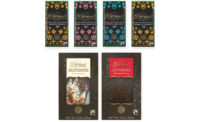Chocolate bars are a well-established area of the confectionery industry, but manufacturers are constantly adjusting and innovating to satisfy consumers’ changing demands.
“Traditional large manufacturers are moving towards cleaner ingredients and more transparency on their labels, driven by consumer demands,” says Scott Kucirek, ceo of OCHO Candy. “Smaller players are providing the innovation in the category from creating bars that are all organic or natural, bars that provide nutritional benefits, or bars that use healthier inclusions.”

OCHO Candy is one of those smaller players seeking to innovate within the category. The company’s bars are all organic, putting a new twist on familiar and well-loved flavors like Peanut Butter, Caramel & Peanut, and Dark Coffee. What makes OCHO Candy’s bars different is the fact that all of its ingredients are non-GMO, containing no artificial flavors, fillers, or preservatives. All of the bars are certified gluten-free and the Coconut bar is certified vegan.
The bars are delicious, but consumers didn’t always know that.
“Early on in 2011 and 2012, we met resistance because most consumers felt that an organic candy bar wouldn’t taste very good,” says Kucirek. “However, once people tasted our candy bars, then they were pleasantly surprised and that helped us grow.”
The other challenge was keeping up with demand. OCHO Candy was limited by its production capabilities until early 2016, when the company opened its automated facility. Before this year, every OCHO Candy bar was hand-made and hand-filled.
Now that the plant is open, the company can finally spread the word about their products and discuss the brand and why organic could be the future of traditional candy bars.

But OCHO Candy isn’t the only company that thinks organic has a future in candy.
Artisana Organic Foods, a company that makes organic nut butters, also has a line of chocolate bars made with organic Venezuelan Criollo cacao sourced from a family-owned farm that has grown Criollo cacao since the 1700s. The bars are non-GMO, kosher, Rainforest Alliance Certified, vegan, and gluten-free. They are all dark chocolate, coming in three varieties: 65%, 75%, and 85%. The chocolates accompany a range of products including nut butters, coconut butter and oil, and chocolate spreads.
As far as innovation goes, nutrition also plays a role.
Seattle Chocolates recently launched what it calls “the newest superfood chocolate from jcoco.” The company’s new bar is called A Super Chocolate Dark Chocolate Truffle Bar Powered by CoffeeFlour & Cocoa Nibs. It’s a chocolate bar infused with CoffeeFlour, a nutrient-dense super-ingredient made from dried coffee cherry pulp. The pulp, a largely wasted by-product of green coffee production, can be converted into a nutrient-rich ingredient suitable for cooking and baking. Its smoky, citrus, and roasted fruit notes allow CoffeeFlour to add a unique flavor to chocolate.
CoffeeFlour also contains more protein per gram than fresh kale, more potassium per gram than a banana, more iron per gram than fresh spinach, five times more fiber than whole grain wheat flour, and 42 percent more fiber than coconut flour.
Combined with responsibly sourced, Rainforest Alliance Certified cocoa, the new bar combines quality chocolate with a new, better-for-you ingredient.
Ross Chocolates also addresses health demands, in a different way.
The company manufactures chocolate with no sugar added, instead using a corn-based sweetener called malitol to sweeten its products. The bars are made with Belgian chocolate and are a diabetic-friendly, low-calorie alternative to traditional chocolate bars. Available in nine flavors, the bars promise to satisfy all different tastes.
Putting a new twist on traditional favorites has yet another avenue for innovation in the chocolate bar category.
Mars, for one, is taking well-loved classics like Snickers and putting new spins on them with flavors like Snickers Crisper and Snickers Hazelnut.

Boasting multiple textures, the new Snickers Crisper adds a satisfying crisp texture to an already satisfying crunch. The addition of crisped rice addresses consumer desires for new textures in their snacking options. Meanwhile, the Snickers Hazelnut comes in response to consumer testing that revealed hazelnut to be the most incremental and consumer-preferred single-product addition to the existing Snickers portfolio.
Mars has also launched the Twix White Chocolate Cookie Bar, enrobing the traditional Twix Cookie Bar in white chocolate. With the white chocolate segment growing, this new Twix bar will help drive core consumers while creating news and giving them the variety they crave.
When it comes to making great candy bars, though, OCHO Candy’s Kucirek believes there are a few key ingredients.
“At OCHO Candy, our number one focus is making the world’s best-tasting candy bars,” he says. “All other decisions (manufacturing, ingredient sourcing, hiring, etc.) are based on whether or not our actions will allow us to achieve our primary objective.”
After that, in a more practical sense, it’s important to source high-quality, great-tasting ingredients and put quality control policies in place.
“It starts with the corporate culture and the priorities of the company,” he says.





